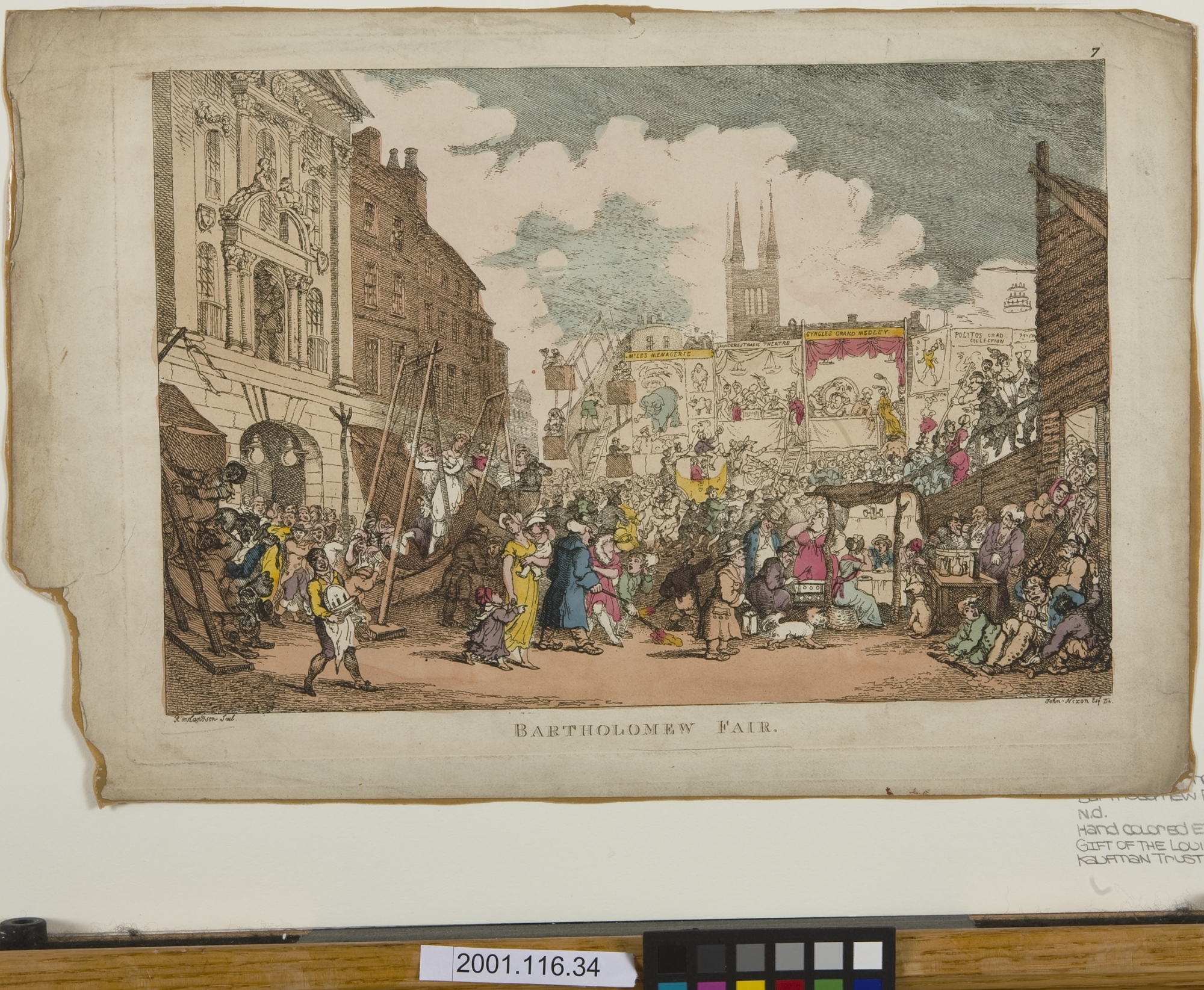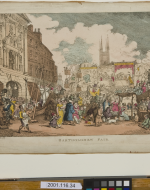Created by Viviana Moreno on Tue, 02/08/2022 - 02:14
Description:
Originally a cloth fair, and beginning in 1133, the Bartholomew Fair was founded in West Smithfield, just beyond the London city walls. It was a pilgrimage and festival and by 1955 it developed into a major, two-week long fair with trading and entertainment that started each year on August 24th. This fair attracted crowds from all levels of English society: “It more or less illustrated the social history of the metropolis, and in some sort its trading practices” (Walford 164). It was also known as the biggest of the London fairs, bringing spectacle to people’s lives.
The very origin of fairs lies in Charter Fairs: holidays, initially, in which there was an intermission of labor and pleadings. In later centuries, they began to be known as street fairs or local markets, central to commerce and trade. Bartholomew Fair was by far the largest and most spectacular event of its kind: it was the scene of much public excitement. In 1969 it was shortened to 4 days, and it was held in this part of London during that time. By this time, the fair had become more of a carnival than a place with a business function. The thousands of visitors who went there could watch plenty of entertainment shows and spectacles: tumblers, acrobats, and tightrope walkers, for example, or exhibitions of exotic animals, boxing competitions, puppet shows and displays of human strength. There were dozens of ‘booths’ selling a wide range of foods such as gingerbread, nuts, puddings, sausages and hot pies to the huge crowds. Vast quantities of alcohol were consumed there, which was the cause of much concern to local authorities. This image from 1808 shows details of these entertainments.
After a while, the spectacles offered at the fair were intended to shock and amuse rather than edify their audience. This painting depicts this sense of shocked spectatorship not only by providing the viewer with such sights and a sense of chaos, but by offering a scene that hints at the illicit activities and sights the depicted fairgoers are likely, in this site of disorder and tumult, to see. Richard Cavendish explains that, as years passed “By the 1840s it was a shadow of its old self, and it made its last bow in 1855”.
The King was an important figure in this time, and one that prevailed in the next eras. He was the one who made the rules for the Bartholomew Fair, as well as being the one who said it should be stopped. Most of the people questioned the Christian implications of trying to stop a place of this morality, and it was seen in here that “Many questioned various claims to religious authority” (356), as Pinciss describes. It might be here where the spread for romantic ideas came from because of the impact this Fair had in society: freedom from rules, spontaneity, an emphasis on individualism and solitary life rather than life in society. All of these were seen in this Fair. Because parody and the burlesque would easily go in hand with the chaotic atmosphere that came from the Bartholomew Fair, it became a source of inspiration for literature and art even after it closed.
Works Cited:
Cavendish, Richard. “London's Last Bartholomew Fair.” History Today, https://www.historytoday.com/archive/london%E2%80%99s-last-bartholomew-fair.
G. M. Pinciss. “Bartholomew Fair and Jonsonian Tolerance.” Studies in English Literature, 1500-1900, vol. 35, no. 2, Apr. 1995, pp. 345–59. EBSCOhost, doi-org.ezproxy.uvu.edu/10.2307/451029.
Walford, Cornelius. Fairs, Past and Present: A Chapter in the History of Commerce. London, 1883. Print
Copyright:
Associated Place(s)
Part of Group:
Featured in Exhibit:
Artist:
- William Combe


